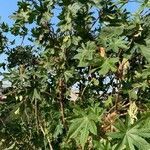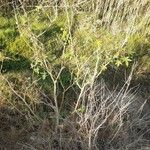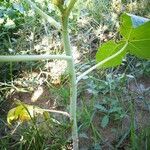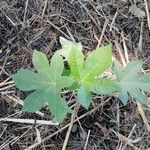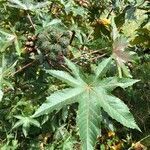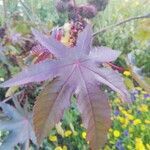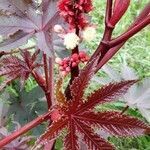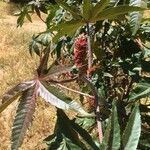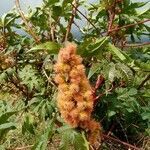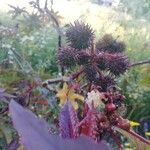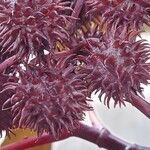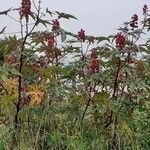Shrub or tree, usually 2-5 m high; twigs (in most varieties) glaucous. Leaves thin, glabrous; petioles 1-2 dm long or more, the gland at apex of petiole on dorsal side of blade, single or sometimes paired, patelliform, dark, subsessile, ca 2-3 mm across; stipules ca 1-1.5 cm long, caducous, leaving a prominent annular scar; blades mostly 7-9-lobed, ca 1 dm across or more (up to 1 m), peltate, the lobes lanceolate, acuminate, pinnately veined, the margins serrate with ? glandular teeth. Panicles terminal, bisexual, the 3-10 lowermost nodes with clusters of several male flowers, the distal nodes female (a few intermediate nodes often hymaphroditic bracts papery, associated with dark patelliform glands. Staminate flowers with articulate pedicels ca 5-15 mm long; calyx-lobes lanceolate, acute, ca 4-9 mm long; androe-cium ca 5-7 mm wide, the anthers 0.3-0.4 mm long. Pistillate flowers with pedi-cels becoming mostly 1.5-3 cm long in fruit; calyx-lobes mostly 5, lanceolate, acute, ca 3-4 mm long, persistent or deciduous; ovary coarsely muricate, the styles bifid or bipartite, reddish, densely papillose, ca 3-4 mm long. Capsules ordinarily echinate, 12-21 mm in diam, the columella wing-dilated distally, ca 1 cm long or more; seeds ellipsoidal, somewhat flattened, diversely mottled, 9-22 mm long, 4.5-9 mm broad.
Plants 1–4[–5+] m. Stems erect. Leaves: stipules 2–3 cm, connate, leaving conspicuous scar around stem; petiole 10–55 cm, with (0–)1–3 cuplike glands on proximal adaxial surface, 2 glands at apex adaxially; blade circular in outline, 15–50 cm diam., base peltate, marginal teeth gland-tipped, laminar glands scattered on adaxial surface, lobes 7–12, lanceolate or oblanceolate, increasing in size apically, apex narrowly acute to acuminate. Inflorescences 6–30 cm, to 45 cm in fruit; bracts caducous except for 2 persistent glands. Pedicels: staminate 5–15 mm; pistillate 0.5–5 mm, elongating to 40 mm in fruit. Staminate flowers: calyx lobes ovate, 7–8 mm; stamen cluster ± spheric, 10–12 mm diam. Pistillate flowers: sepals ovate, 4–5 mm; ovary densely covered in slender-conic, bristle-tipped outgrowths; styles red or orange-red, 4–5 mm; stigmas distinctly spreading, papillose. Capsules dark red, echinate, subglobose, 1.5–2 cm diam. Seeds mottled brown, 8–11 mm, shiny. 2n = 20.
Erect, ± glabrous, shrub up to 4 m high (in colder areas as an annual herb). Stems rounded, smooth or slightly ribbed, softly woody. Lvs alternate, deltate, deeply palmately 5-9-lobed (first few lvs opposite and shallowly lobed); lobes acute to acuminate, irregularly serrate; petiole somewhat > or ± = blade; seedling lvs 6-12 cm diam.; adult lvs 20-40 cm diam.; young lvs with deciduous stipules. Panicle erect, with ♂ fls below, ♀ above; bracts subtending panicle-branches ovate-triangular, entire, deciduous. Pedicel elongating at fruiting; capsule deeply grooved between cells, usually covered in long soft spines, rarely without spines. Seeds rectangular, usually mottled brown or grey, c. 15 mm long.
Herbs erect, often single-stemmed but sometimes bushlike or treelike, 2-5(-10) m tall; younger parts glaucous, whole plant often reddish or purplish. Stipules connate, 2-3 cm; petiole 20-40 cm; leaf blade palmately 7-11-lobed, 30-50(-100) × 30-50(-100) cm, margin serrate. Inflorescence to 30 cm. Male flowers: pedicels 5-17 mm; calyx lobes 5-8 × 3-5 mm; stamens 7-8 mm. Female flowers: pedicels 5-10 mm; sepals ca. 5 mm; styles 2-5 mm. Fruiting pedicel to 45 mm; capsule ellipsoid or ovoid, 1.5-2.5 cm, echinate, spines to ca. 5 mm, sometimes smooth. Seed 7-12 mm, grayish, silvery, or beige with darker markings; caruncle depressed-conical, 2-3 mm wide. Fl. Jun-Sep, or Jan-Dec.
Shrub or small tree to 10 m high. Stipular sheath 13–27 mm long. Leaves: petiole up to 37 cm long; lamina 5–12 lobed (lobes lanceolate-ovate, lanceolate, oblong or linear-oblong), up to 1 m across, glandular-serrate. Inflorescence up to 30 cm long. Males flowers: pedicels 4–8 mm long; calyx lobes ovate, 7–8 mm long, 1.5–4.5 mm wide; anthers c. 0.3 mm long and 0.2 mm wide. Female flowers: pedicels 3–6 mm long; calyx lobes lanceolate, 4–6 mm long, 2.5–2.7 mm wide; ovary c. 4 mm diam; styles 4–8 mm long. Fruit ± globose, 15–16 mm long, 12–15 mm diam. Seeds c. 10 mm long, 6–7 mm wide, 4–5 mm thick, brown and cream mottled.
A small evergreen tree. Often they are grown as annual plants. It grows up to about 6 m high and spreads to 2 m across. The stem is erect, stout and branching. The plant can form suckers. It has leaves with pointy lobes spreading out like fingers on a hand. The leaves are large and glossy. The leaves are on long leaf stalks. The flowers are red and large and woolly. Female flowers are at the top and male flowers lower down. Clusters of flowers produce seed capsules containing 3 spiny seeds. Several different cultivated varieties exist which are chosen for their leaf and flower colour.
Perennial tree or shrub, 0.6-7.0 m high; erect glabrous; single-stemmed; stems hollow. Leaves 5-11-lobed; lobes ovate-lanceolate to lanceolate, acuminate, coarsely glandular-serrate. Inflorescences bracts lanceolate. Male flowers calyx lobes ovate, acute; stamens 7-8 mm long. Female flowers sepals lanceolate, acuminate; ovary 3-lobed to subglobose; styles up to 7 mm long. Flowering time June-Feb. Fruit strongly 3-lobed. Seeds smooth, marbled; caruncle depressed-conic.
Monoecious, spineless, glabrous shrub to tree, up to 5 m tall. Leaves peltate, palmately lobed, up to 300 mm or more in diam. Flowers in a lax, subterminal raceme, without petals; males with many stamens, filaments united at base in repeatedly branching clusters; females with a spathe-like, soon deciduous calyx. Capsule 12-18 mm diam., covered with soft spines.
Leaf blades (5)7–11-lobed, 7–35(100) cm long and wide, with the median lobe 2–8(20) cm wide, and the lateral lobes progressively smaller; lobes ovate-lanceolate to lanceolate, acuminate, coarsely glandular-serrate, dark green on upper surface, paler beneath, the nerves yellowish; lateral nerves in 15–25 pairs on the median lobe.
Tall, stout, glabrous annual (perennial and arborescent in warmer climates) with large (1–4 dm wide), peltate, subrotund, palmately 6–11-lobed lvs and large racemes of fls; seeds 1 cm, violently poisonous; 2n=20. Rarely adventive in waste places with us.
Seeds 7–21 × 5–15 × 4–8 mm, smooth, usually shiny, grey, silvery-white or beige, usually variously streaked, mottled, flecked or blotched with olive-brown, reddish-brown or brownish-black; caruncle 1–2 × 2–3 mm, depressed-conic.
Female flowers: pedicels 0.5–1 cm long, extending to 4.5 cm in fruit; sepals c. 5 mm long, lanceolate, acuminate, often purplish-tinged; ovary 2 mm long and wide, 3-lobed to subglobose; styles up to 7 mm long.
Herbaceous, much-branched shrub or small tree, up to 4 m high. Leaves palmately 7-13-lobed, lobes serrate. Fruit subglobose, ellipsoid or oblong, 10-15 mm long, usually echinate. Flowers yellow.
Male flowers: pedicels up to 1.7 cm long; calyx lobes 5–8 × 2–5 mm, ovate, acute, pale green, often purplish-tinged; stamens 7–8 mm long, anthers 0.5 mm long, pale yellow.
Fruit 1–2.3 cm long and wide, strongly 3-lobed, smooth, or sparingly to densely beset with narrowly-cylindric bristle-tipped processes 3–6 mm long, bluish-green.
Inflorescences 10–30 cm long; bracts c. 1 cm long, lanceolate; bracteoles similar, but smaller.
An erect glabrous pruinose single-stemmed or bushy, tree-like herb up to 7 m high.
Stems up to 10 cm thick at base, hollow, becoming ± woody, grey.
Petioles 4–30 cm long, or longer; glands discoid or turbinate.
Stipular sheath up to 2.7 cm long, ovate, reddish or purplish.
Young shoots often reddish-tinged.
